Unit 4 Where’s my schoolbag-Section A 2d-3c(第2课时)课件+嵌入音频(共27张PPT)
文档属性
| 名称 | Unit 4 Where’s my schoolbag-Section A 2d-3c(第2课时)课件+嵌入音频(共27张PPT) |  | |
| 格式 | pptx | ||
| 文件大小 | 4.6MB | ||
| 资源类型 | 教案 | ||
| 版本资源 | 人教新目标(Go for it)版 | ||
| 科目 | 英语 | ||
| 更新时间 | 2023-09-06 09:36:19 | ||
图片预览

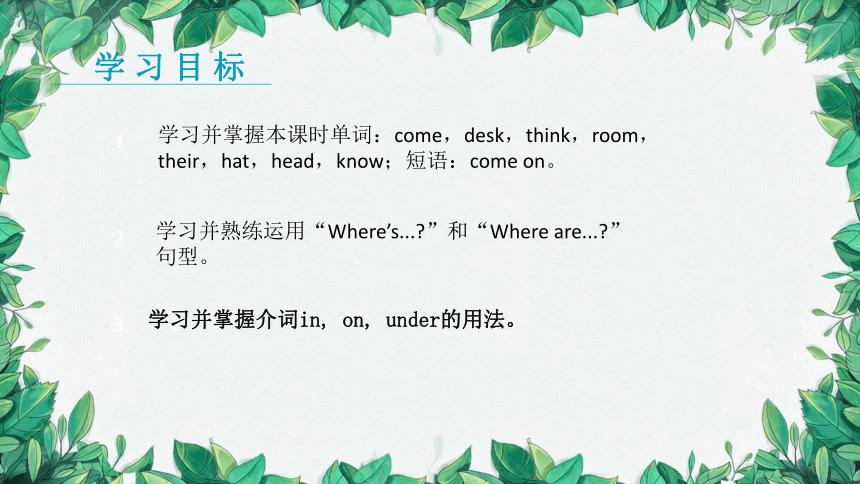

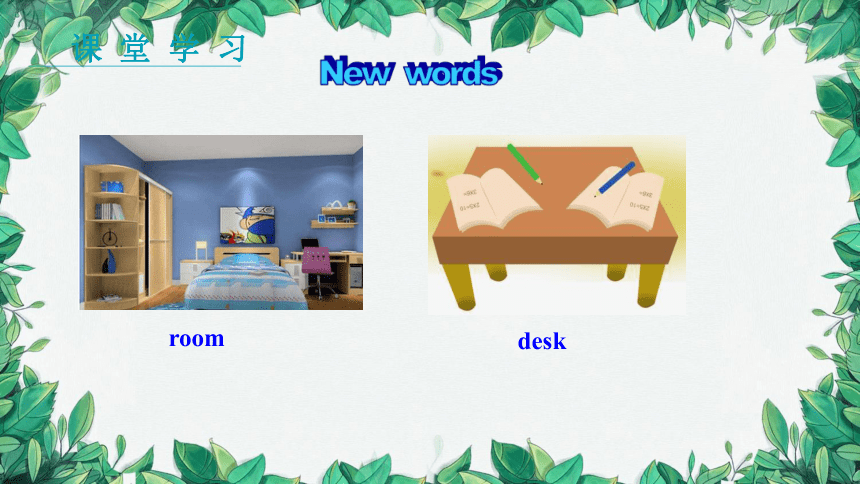
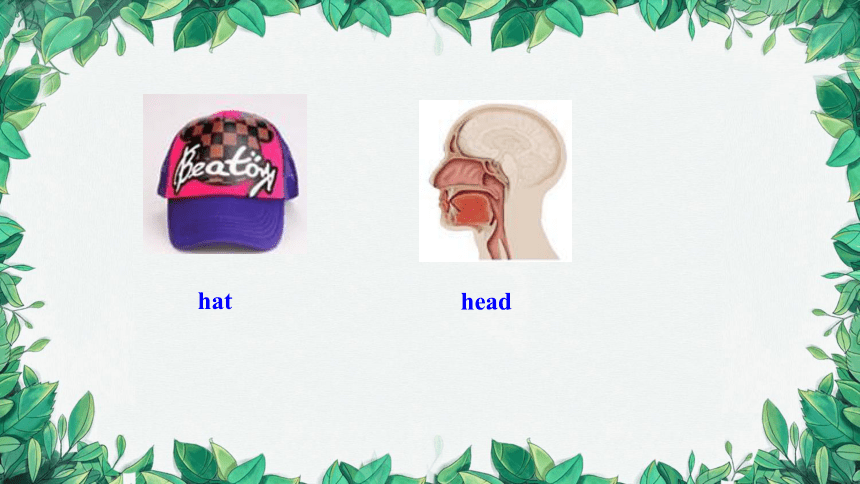

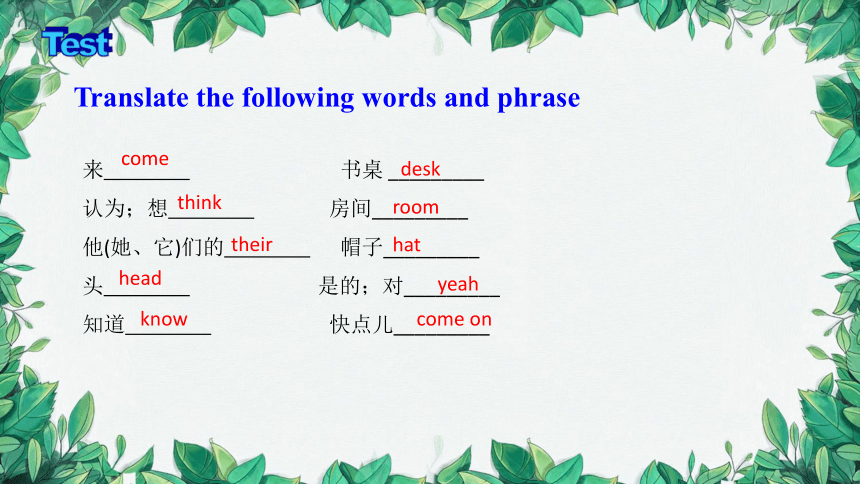

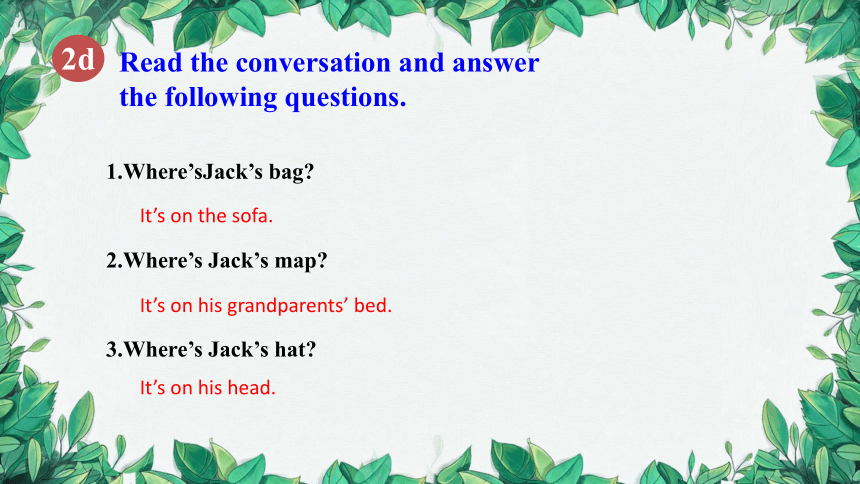
文档简介
(共27张PPT)
Section A(2d—3c)
UNIT 4 Where’s my schoolbag
第 2 课 时
学 习 目 标
学习并熟练运用“Where’s... ”和“Where are... ”句型。
2
2
3
学习并掌握介词in, on, under的用法。
学习并掌握本课时单词:come,desk,think,room,their,hat,head,know;短语:come on。
1
课 堂 导 入
Act out Forgetful!
New words
课 堂 学 习
room
desk
head
hat
come 来,来到
think 认为,想,思考
know 知道,了解
come on 快点儿
Translate the following words and phrase
Test
来 书桌 _________
认为;想 房间_________
他(她、它)们的 帽子_________
头 是的;对_________
知道 快点儿_________
come
desk
think
room
their
hat
head
yeah
know
come on
Listen to the conversation.
Mom: Come on, Jack!
Jack: Oh, no! Where’s my bag
Mom: Hmm…is it on your desk
Jack: No. And it’s not under the chair.
Mom: Oh! It’s on the sofa.
Jack: Thank you, Mom.
Err…where’s the map
Mom: I think it’s in your grandparents’ room.
Jack: Yes, it’s on their bed! And my hat
Mom: It’s on your head!
Jack: Oh, yeah! Haha!
2d
Read the conversation and answer
the following questions.
1.Where’sJack’s bag
2.Where’s Jack’s map
3.Where’s Jack’s hat
2d
It’s on the sofa.
It’s on his grandparents’ bed.
It’s on his head.
Role-play the conversation.
Mom: Come on, Jack!
Jack: Oh, no! Where’s my bag
Mom: Hmm…is it on your desk
Jack: No. And it’s not under the chair.
Mom: Oh! It’s on the sofa.
Jack: Thank you, Mom.
Err…where’s the map
Mom: I think it’s in your grandparents’ room.
Jack: Yes, it’s on their bed! And my hat
Mom: It’s on your head!
Jack: Oh, yeah! Haha!
2d
1. Come on, Jack!
(1)come 作不及物动词,意为“来”。其过去式为came。
Jim comes to my home every day. 吉姆每天都来我家。
(2)Come on!用于表示催促、鼓励、安慰等。此处表示催促,含义是“赶快,快点儿”。类似的情况还可用Hurry (up)!表示催促。
Harry up, David! We’re late.赶快,戴维!我们要晚了。
【拓展】 老师让学生回答问题时,说Come on!表示鼓励学生回答,不用怕。观看体育比赛时,呼喊Come on!表示“加油!”
Language points
2. I think it’s in your grandparents’ room.
(1) I think意为“我认为”,用于表述自己的主观想法或看法,后常跟that
引导的从句作宾语。口语中常常省略that。
I think (that) he is right. 我认为他是对的。
(2) grandparents’是grandparents的所有格形式,意为“(外)祖父母的”。
名词所有格常在名词前作定语。通常,单数名词加’s来构成所有格,而
以-s结尾的复数名词则直接加’来构成所有格。
This is my parents’ house.这是我父母的房子。
Questions Answers
Where’s the map It’s in your grandparents’ room.
Where are my books They’re on the sofa.
Where’s his pencil box It’s in his schoolbag.
Where’s your ruler It’s under the chair.
Where are their keys They’re on the table.
Where’s = Where is
课 堂 学 习
Grammar Focus
where 开头的特殊疑问句
用来询问人或物在什么地方。其结构为:Where + is / are + 主语(人或物)?回答时不能用 Yes 或 No,而应根据实际情况回答出物品所在的位置。
-- Where are your keys
你的钥匙在哪里?
-- They’re in my room.
它们在我的房间里。
Language points
2. Where is+主语(单数)
Where are+主语(复数)
谓语动词用is还是are取决于主语的人称和数。
如果主语是人,回答时用相应的人称代词主格作主语;
如果主语是单数物品,回答时用“It’s + 表示地点的词”;
如果主语是复数物品,回答时用“They’re + 表示地点的词”。
⑴ -- Where is your English teacher
你的英语老师在哪里?
-- He is in the classroom. 他在教室里。
⑵ -- Where are the pencils
铅笔在哪里?
-- They are in the pencil box.
它们在铅笔盒里。
in
on
under
3. 方位介词 in, on, under
在……里面
在……上面
在……下面
in, on 与under
(1)in表示“在……里”,指在某个空间的内部。
(2)on表示“在……上”,指某人或某物在另一物体的上面,两者之间有接触。
(3)under表示“在……下”,指某人或某物在另一物体的垂直下方,两者之间没有接触。
Make a survey about your classmates’ things using “Where is/are... ”And then fill in the chart.
A: Where the keys
B: They’re the .
A: Where’s the
it on your desk
B: No, it’s the chair.
A: Where the pencils
B: I don’t know.
hey in the
A: Yes, they are.
Look at the pictures and complete the conversations.
are
on
desk
book
Is
under
are
Are
schoolbag
3a
我不知道。
Complete the sentences.
1. — your books —They’re on the desk.
2. —Where’s your baseball — under the chair.
3. —Where are his pencils — in the pencil box.
4. — her computer —It’s on the desk.
5. —Is the book in the schoolbag —No, .
6. —Are they on the desk —Yes, .
Where are
It’s
They’re
Where’s
it isn’t
they are
Ask and answer questions about the things on the right.
A: Where are the books
B: They are on the sofa.
3b
Student A, look at the picture on page 19. Student B, look at the picture on the right. Ask and answer questions to find the differences.
A:Where's the schoolbag Is it under the table
B:No,it isn't. It's on the table.
3c
Fill in the chart according to the pictures on page 19.
Make a report according to the chart.
Model:In Picture 1,the pencil box is...
In Picture 2,the pencil box is...
We have learnt in this lesson:
New words and a phrase:room,desk,hat,head,come,think,know,their,come on.
Sentence structures:Where’s... It’s on/in/under...
Where are... They’re...on/in/under...
Summary
1. Remember the new words in Section A.
2. Ask the students to make a dialogue like 3c.
Homework
Thank you !
Section A(2d—3c)
UNIT 4 Where’s my schoolbag
第 2 课 时
学 习 目 标
学习并熟练运用“Where’s... ”和“Where are... ”句型。
2
2
3
学习并掌握介词in, on, under的用法。
学习并掌握本课时单词:come,desk,think,room,their,hat,head,know;短语:come on。
1
课 堂 导 入
Act out Forgetful!
New words
课 堂 学 习
room
desk
head
hat
come 来,来到
think 认为,想,思考
know 知道,了解
come on 快点儿
Translate the following words and phrase
Test
来 书桌 _________
认为;想 房间_________
他(她、它)们的 帽子_________
头 是的;对_________
知道 快点儿_________
come
desk
think
room
their
hat
head
yeah
know
come on
Listen to the conversation.
Mom: Come on, Jack!
Jack: Oh, no! Where’s my bag
Mom: Hmm…is it on your desk
Jack: No. And it’s not under the chair.
Mom: Oh! It’s on the sofa.
Jack: Thank you, Mom.
Err…where’s the map
Mom: I think it’s in your grandparents’ room.
Jack: Yes, it’s on their bed! And my hat
Mom: It’s on your head!
Jack: Oh, yeah! Haha!
2d
Read the conversation and answer
the following questions.
1.Where’sJack’s bag
2.Where’s Jack’s map
3.Where’s Jack’s hat
2d
It’s on the sofa.
It’s on his grandparents’ bed.
It’s on his head.
Role-play the conversation.
Mom: Come on, Jack!
Jack: Oh, no! Where’s my bag
Mom: Hmm…is it on your desk
Jack: No. And it’s not under the chair.
Mom: Oh! It’s on the sofa.
Jack: Thank you, Mom.
Err…where’s the map
Mom: I think it’s in your grandparents’ room.
Jack: Yes, it’s on their bed! And my hat
Mom: It’s on your head!
Jack: Oh, yeah! Haha!
2d
1. Come on, Jack!
(1)come 作不及物动词,意为“来”。其过去式为came。
Jim comes to my home every day. 吉姆每天都来我家。
(2)Come on!用于表示催促、鼓励、安慰等。此处表示催促,含义是“赶快,快点儿”。类似的情况还可用Hurry (up)!表示催促。
Harry up, David! We’re late.赶快,戴维!我们要晚了。
【拓展】 老师让学生回答问题时,说Come on!表示鼓励学生回答,不用怕。观看体育比赛时,呼喊Come on!表示“加油!”
Language points
2. I think it’s in your grandparents’ room.
(1) I think意为“我认为”,用于表述自己的主观想法或看法,后常跟that
引导的从句作宾语。口语中常常省略that。
I think (that) he is right. 我认为他是对的。
(2) grandparents’是grandparents的所有格形式,意为“(外)祖父母的”。
名词所有格常在名词前作定语。通常,单数名词加’s来构成所有格,而
以-s结尾的复数名词则直接加’来构成所有格。
This is my parents’ house.这是我父母的房子。
Questions Answers
Where’s the map It’s in your grandparents’ room.
Where are my books They’re on the sofa.
Where’s his pencil box It’s in his schoolbag.
Where’s your ruler It’s under the chair.
Where are their keys They’re on the table.
Where’s = Where is
课 堂 学 习
Grammar Focus
where 开头的特殊疑问句
用来询问人或物在什么地方。其结构为:Where + is / are + 主语(人或物)?回答时不能用 Yes 或 No,而应根据实际情况回答出物品所在的位置。
-- Where are your keys
你的钥匙在哪里?
-- They’re in my room.
它们在我的房间里。
Language points
2. Where is+主语(单数)
Where are+主语(复数)
谓语动词用is还是are取决于主语的人称和数。
如果主语是人,回答时用相应的人称代词主格作主语;
如果主语是单数物品,回答时用“It’s + 表示地点的词”;
如果主语是复数物品,回答时用“They’re + 表示地点的词”。
⑴ -- Where is your English teacher
你的英语老师在哪里?
-- He is in the classroom. 他在教室里。
⑵ -- Where are the pencils
铅笔在哪里?
-- They are in the pencil box.
它们在铅笔盒里。
in
on
under
3. 方位介词 in, on, under
在……里面
在……上面
在……下面
in, on 与under
(1)in表示“在……里”,指在某个空间的内部。
(2)on表示“在……上”,指某人或某物在另一物体的上面,两者之间有接触。
(3)under表示“在……下”,指某人或某物在另一物体的垂直下方,两者之间没有接触。
Make a survey about your classmates’ things using “Where is/are... ”And then fill in the chart.
A: Where the keys
B: They’re the .
A: Where’s the
it on your desk
B: No, it’s the chair.
A: Where the pencils
B: I don’t know.
hey in the
A: Yes, they are.
Look at the pictures and complete the conversations.
are
on
desk
book
Is
under
are
Are
schoolbag
3a
我不知道。
Complete the sentences.
1. — your books —They’re on the desk.
2. —Where’s your baseball — under the chair.
3. —Where are his pencils — in the pencil box.
4. — her computer —It’s on the desk.
5. —Is the book in the schoolbag —No, .
6. —Are they on the desk —Yes, .
Where are
It’s
They’re
Where’s
it isn’t
they are
Ask and answer questions about the things on the right.
A: Where are the books
B: They are on the sofa.
3b
Student A, look at the picture on page 19. Student B, look at the picture on the right. Ask and answer questions to find the differences.
A:Where's the schoolbag Is it under the table
B:No,it isn't. It's on the table.
3c
Fill in the chart according to the pictures on page 19.
Make a report according to the chart.
Model:In Picture 1,the pencil box is...
In Picture 2,the pencil box is...
We have learnt in this lesson:
New words and a phrase:room,desk,hat,head,come,think,know,their,come on.
Sentence structures:Where’s... It’s on/in/under...
Where are... They’re...on/in/under...
Summary
1. Remember the new words in Section A.
2. Ask the students to make a dialogue like 3c.
Homework
Thank you !
同课章节目录
- starters 预备篇(2012秋审查)
- Unit 1 Good morning !
- Unit 2 What’s this in English?
- Unit 3 What color is it ?
- Unit 1 My name's Gina.
- Section A
- Section B
- Unit 2 This is my sister.
- Section A
- Section B
- Unit 3 Is this your pencil?
- Section A
- Section B
- Unit 4 Where's my schoolbag?
- Section A
- Section B
- Unit 5 Do you have a soccer ball?
- Section A
- Section B
- Unit 6 Do you like bananas?
- Section A
- Section B
- Unit 7 How much are these socks?
- Section A
- Section B
- Unit 8 When is your birthday?
- Section A
- Section B
- Unit 9 My favorite subject is science.
- Section A
- Section B
